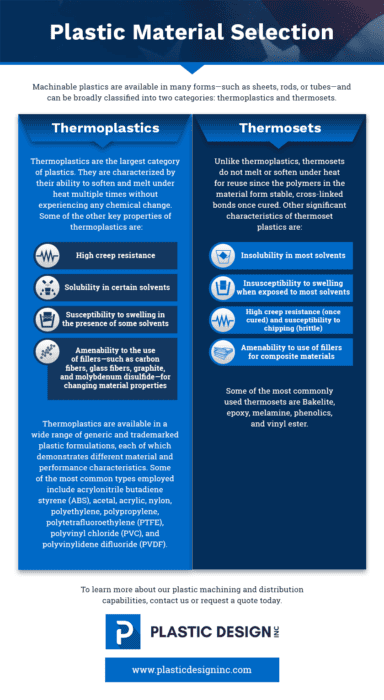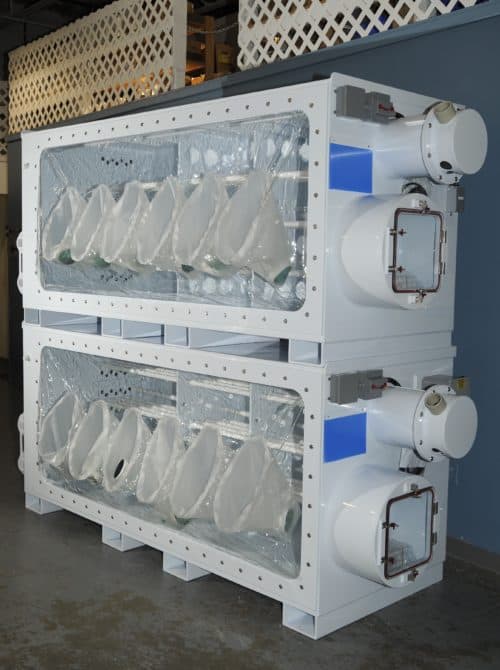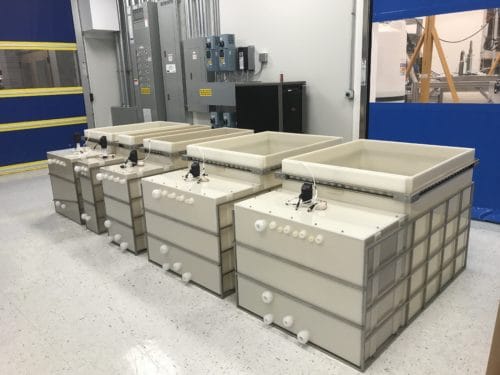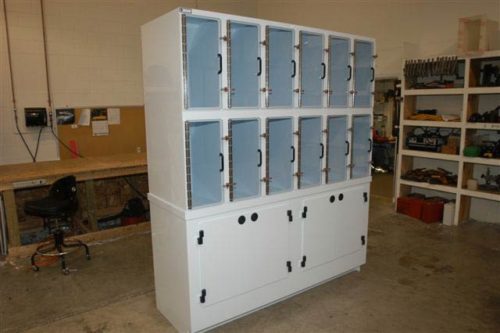Common Materials for Machining Plastic
Comments Off on Common Materials for Machining PlasticWhen manufacturing plastic components, many companies turn to molding techniques to produce the necessary parts and products. However, this method often proves expensive and time consuming.
Machining serves as an alternative to molding that creates small quantities of complex and close tolerance plastic parts quickly. Since the workpiece has to be rigid enough to withstand operations without warping or bending, not all types of plastics are suitable for machining. Despite these restrictions, there remain several plastics of varying costs and performance characteristics that are machinable.
Plastic Material Selection
Machinable plastics are available in many forms—such as sheets, rods, or tubes—and can be broadly classified into two categories: thermoplastics and thermosets.
 Thermoplastics
Thermoplastics
Thermoplastics are the largest category of plastics. They are characterized by their ability to soften and melt under heat multiple times without experiencing any chemical change. Some of the other key properties of thermoplastics are:
- High creep resistance
- Solubility in certain solvents
- Susceptibility to swelling in the presence of some solvents
- Amenability to the use of fillers—such as carbon fibers, glass fibers, graphite, and molybdenum disulfide—for changing material properties
Thermoplastics are available in a wide range of generic and trademarked plastic formulations, each of which demonstrates different material and performance characteristics. Some of the most common types employed include acrylonitrile butadiene styrene (ABS), acetal, acrylic, nylon, polyethylene, polypropylene, polytetrafluoroethylene (PTFE), polyvinyl chloride (PVC), and polyvinylidene difluoride (PVDF).
Thermosets
Unlike thermoplastics, thermosets do not melt or soften under heat for reuse since the polymers in the material form stable, cross-linked bonds once cured. Other significant characteristics of thermoset plastics are:
- Insolubility in most solvents
- Insusceptibility to swelling when exposed to most solvents
- High creep resistance (once cured) and susceptibility to chipping (brittle)
- Amenability to use of fillers for composite materials
Some of the most commonly used thermosets are Bakelite, epoxy, melamine, phenolics, and vinyl ester.
Material Characteristics of Common Machined Plastics
When selecting a plastic material for a machining application, there are two main factors to consider: (a) suitability of the plastic’s properties for the application and (b) its suitability for machining. Some of the characteristics that machined plastic parts can have are:
- Biocompatibility: targeted toward medical and pharmaceutical applications where machined parts must not cause biological reactions in patients
- Chemical resistance: important for parts used in the agricultural, chemical, and food and beverage industries as parts must not dissolve or degrade when they come in contact with chemicals
- Dimensional stability: an important property for outdoor parts that are exposed to varying stress and environmental conditions
- FDA classification: plastics used in food and beverage industry applications must be approved by the FDA
- Impact resistance: some plastics, such as polycarbonate, offer greater impact resistance than glass, making them suitable for use in high impact or stress applications
- Loading strength: the ability of the plastic to withstand compressive and tensile loads
- Temperature resistance: depending on the specifications of the application, the plastic material must be able to perform well under a wide range of temperatures
- UV resistance: an important property for outdoor applications
- Wear resistance: plastic parts used in high speed or high torque applications must have good resistance to wear
Industries and Applications
Machined plastic parts find application across a diverse set of industries as components of cabinets, carts, enclosures and tanks, fume hoods, laboratory equipment, light lenses, point-of-purchase (POP) displays, sign holders, and more. Some of the industries that use machined plastic parts are:
- Biomedical

- Electronics
- Life sciences and animal research
- Lighting
- Marine
- Original equipment manufacturing (OEM)
- Pharmaceutical
- Photonics
- Recreational
- Semiconductor
Plastic Solutions From Plastic Design, Inc.
At Plastic Design, Inc., we have over 40 years of experience designing, prototyping, and manufacturing machined plastic parts for a wide range of industries. We can fabricate parts to standards such as Factory Mutual, Semi, NFPA, and OSHA or custom specifications and maintain ISO 9001:2015, I.P.C.A. 620, and confined space entry certifications. Regardless of whether you need a one-off prototype or a large production run, we can meet your machined plastic needs.
In addition to our design and manufacturing capabilities, we also offer the following services:
- On-site installation
- Support
- Stocking and distribution of plastic materials in various forms, including extruded and molded rods, sheets, and flexible and rigid tubes.
To learn more about our plastic machining and distribution capabilities, contact us or request a quote today.
Plastic Machining Guide
Comments Off on Plastic Machining GuideMachining is an umbrella term for the controlled, subtractive manufacturing techniques used to produce parts made from a wide range of materials. Today, many companies employ computer numerical control (CNC) machining to achieve greater precision and accuracy in their end products.
When deciding on a machining method for a part, it is essential to keep in mind the design and construction material as these factors significantly impact the production process and final result. For plastic machining projects, these considerations are especially important due to the greater susceptibility of plastic materials to warping, cracking, and deformation when improperly handled. Further exacerbating the problem is the broad selection of plastics and plastic composites available, with each type exhibiting its own properties and best use cases. Altogether, these challenges necessitate partnering with a supplier who demonstrates a deep understanding of your chosen material.
With over 40 years of experience in plastic fabrication, Plastic Design, Inc. has the knowledge and skills necessary to take on any plastic machining challenge. Equipped with state-of-the-art CNC machining equipment, our expert team has the means to perform several different types of machining processes on a variety of industrial plastics to execute the optimal manufacturing plan for every product.
An Overview of Plastic Machining Services
 Like all machining processes, plastic machining is a subtractive method that removes layers of material to shape and form the end part or product. Some of the most common machining operations employed for plastic materials are:
Like all machining processes, plastic machining is a subtractive method that removes layers of material to shape and form the end part or product. Some of the most common machining operations employed for plastic materials are:
Cutting
Generally, cutting operations generate some amount of heat, which can damage the plastic material. When cutting plastics, operators must take care to avoid causing thermal warping. With proper precautions, sawing is completely appropriate for cutting plastic sheets to a desired size and shape.
Turning
Plastic turning operations occur on a lathe, which rotates and manipulates the workpiece to allow the stationary cutting tool to cut and remove excess material as per the intended design.
Milling
While turning operations involve the rotation of the plastic workpiece, milling operations require the rotation of the cutting tool to remove chips of plastic from the stationary workpiece. Some milling techniques work better with plastics than others (such as down-milling), but the ideal choice depends on a number of factors.
Drilling
Drilling plastics can be risky, resulting in overheating or shearing if the proper drill isn’t selected. However, given the proper preparation and tools, a skilled technician can create both small and large diameter holes in a plastic product without damaging its structure.
Grinding
Grinding is similar to milling in that the process removes chips of plastic from the workpiece to alter its shape. The main difference is that milling uses intermittent cuts, whereas grinding continuously shears plastic from the product to achieve a smoother shape and surface finish.
Common Materials Used in Plastic Machining
Plastics present some challenges for machining operations. For example, some plastic materials can have:
 Lower thermal resistance than metals, resulting in a higher risk of thermal expansion, overheating, and thermal damage
Lower thermal resistance than metals, resulting in a higher risk of thermal expansion, overheating, and thermal damage- Higher material costs
- Greater machining restrictions
Despite these limitations, plastic remains a common construction material for machined parts and products. In general, plastics offer several manufacturing advantages, such as:
- Superior strength-to-weight ratios
- Broader insulating properties (including electric, thermal, and vibration)
- Greater resistance to corrosion and chemicals
Specific plastics also maintain their own unique benefits. For example, the following are some of the most commonly used plastics in machining operations:
- Ultra-high molecular polyethylene (UHMW), due to its high machinability
- Nylon, due to its affordability, strength, durability, and corrosion and chemical resistance
- Acrylic, due to its formability, high tensile strength, and resistance to cracking and abrasion
- Polyether ether ketone (PEEK), due to its chemical and wear resistance and ability to withstand high temperatures
Considerations for Plastic Machining
Ensuring the success of a plastic machining project requires choosing construction materials and machining operations that are well-suited for each other. When planning a plastic machining project, some of the factors to consider are:
Plastic type
Different chemical compositions yield different physical characteristics, impacting everything from strength and chemical resistance to the cost of the material. When choosing a plastic material for a machined part, it is important to keep these properties in mind as they will influence how well the material withstands the stresses of manufacturing and the end product withstands the stresses of the intended application.
Thermal regulation
In general, plastics melt at substantially lower temperatures than metals. As such, proper heat regulation, including the use of coolants, is essential if a polymer is to withstand machining.
Process support
As plastics are less rigid than metals, the vibrations generated by the machining operations can more easily cause burrs, cracks, and chatter marks. Incorporating additional support structures during machining operations reduces the risk of damage to the end product.
Finishing options
Many companies employ finishing services to enhance the functional and aesthetic properties of a machined product. Some of the typical finishing processes are annealing, polishing, and coating.
Applications of Plastic Machining
 Considering the benefits and limitations in sum, plastic machining is still one of the best options for producing a variety of industrial parts and products, such as:
Considering the benefits and limitations in sum, plastic machining is still one of the best options for producing a variety of industrial parts and products, such as:
- Biomedical and pharmaceutical devices
- Chemical handling equipment
- Food handling components
- Laboratory and scientific equipment
- Microelectronics
- Photonics
- Semiconductor components
Plastic Machining Services From Plastic Design, Inc.
At Plastic Design, Inc., we have the tools and knowledge required to machine nearly any plastic product. Our expert team takes projects from initial design to delivery of a turnkey product or system.
Our Plastic Machining Capabilities
We use cutting-edge CNC machines to craft precise plastic parts and components to tight tolerances. Our machining capabilities are as follows:
| Machining Operations |
|
| Plastic Forms |
|
| Plastic Materials |
|
| Sizes |
|
| Production Volumes |
|
Additional Capabilities
In addition to our plastic machining capabilities, we also offer:
Original Equipment Manufacturing
Over our years serving customers in the biomedical, pharmaceutical research, and semiconductor industries, we’ve garnered significant knowledge about the requirements expected for the equipment and systems used in the industries. This expertise allows us to serve as an original equipment manufacturer (OEM) of custom-built parts and equipment. With our OEM services, we provide technical guidance to take products from concept to completion.
Specialty Product Manufacturing
Outside of our OEM partnerships, we also manufacture a full catalog of specialty products for customers across a wide range of industries. Some of these past projects have included:
- Automated wet process systems
- Desiccators
- Fume hoods
- Hazardous waste systems
- Tank lines
What Makes Us Different?
At Plastic Design, we are an ISO 9001:2015 certified fabricator. By partnering with us for their plastic machining needs, our customers benefit from our:
- Over 40 years of experience in plastic manufacturing
- Knowledge of specialized fields, including the biomedical, pharmaceutical, and semiconductor industries
- 30,000-square-foot fabrication facility
- OEM manufacturing capabilities
These characteristics allow us to meet some of the most difficult design challenges out there while forming lasting relationships with our industry clients.
Plastic Machining Solutions From Plastic Design, Inc.
Choosing a knowledgeable manufacturer for a plastic machining operation is the key to successful completion of the project. Plastics require specialized expertise to prevent expensive defects or product failures during production, and only a dedicated plastics provider can guide you through the complex material selection and testing process.
At Plastic Design, Inc., we have the technical capabilities and industry knowledge necessary to produce high-quality and cost-effective parts and products from a wide range of plastics. Whether you’re seeking a one-off prototype or a high-volume production run, we’ll work with you to turn your design into a reality.
To learn more about our plastic machining capabilities, contact us or request a quote today.
Choosing a Material for Plastic Chemical Tanks
Comments Off on Choosing a Material for Plastic Chemical TanksPlastic chemical tanks are used for holding and storing harsh and corrosive chemicals in a variety of applications across many industries. Plastics are versatile, inexpensive to manufacture, and chemically adaptable—properties that have led to the replacement of expensive stainless steel tanks throughout manufacturing processes for biomedical, pharmaceutical, and semiconductor industries. Because some plastics can react with different chemicals, heat, or pressure, tanks must be designed using materials specifically tailored for the chemicals and processes they need to hold.
Industries for Plastic Chemical Tanks
Biomedical and Pharmaceutical
You will often find plastic chemical tanks used in the biomedical and pharmaceutical industries, where they are employed to store, drain, and mix chemical compounds. The tanks need to be composed of materials that will not interact with or leach into the compounds they are holding. Tanks for pharmaceutical and biomedical use are often constructed using rigorously tested USP Class VI Certified plastics to ensure biocompatibility and prevent toxic interactions with the chemicals in use.
Semiconductor
Plastic chemical tanks used in the semiconductor industry must be highly resistant to corrosion and safe for sterile use in clean rooms. They are useful in harsh environments for the manufacture of circuitry and electronic components for semiconductor equipment. The tanks must be constructed of durable and highly inert plastics to withstand the hot gas, aggressive chemicals, and high-pressure used in the industry, as well as avoid corrosion and a reaction with the materials being used.
Common Materials Used in Plastic Tanks
Depending on their intended use, plastic tanks must be carefully constructed to tolerate various volatile circumstances without risk of corrosion or leaching. As such, a number of different plastic materials are used in their construction.
- Polypropylene is a versatile semi-crystalline material that is highly chemically resistant at low temperatures, but can be less stable at very high temperatures.
- Polyvinylidene difluoride, or PVDF, is a strong fluropolymer that has high chemical resistance, but is less stable at high temperatures.
- High Density Polyethylene, or HDPE, is an opaque semi-crystalline thermoplastic that is highly chemical resistant and impact resistant at low temperatures.
- PVC, or polyvinyl chloride, comes in both rigid and flexible varieties. It is highly resistant to corrosion and has fair to good chemical resistance.
Properties of Each Material
Each plastic material has physical and chemical properties that help determine which is best for a given chemical or application. When choosing a material, consider the tensile strength, dielectric strength, and maximum operating temperature of each material to ensure that the ideal material is being used in each circumstance. Below is a short list of the important physical properties of each of the plastics commonly used in plastic tanks:
Polypropylene
- Tensile Strength (MPa): 33
- Dielectric Strength (MV/m): 28
- Maximum Operating Temperature: (°C): 100
PVDF
- Tensile Strength: 35
- Dielectric Strength (MV/m): 13
- Maximum Operating Temperature: (°C): 150
HDPE
- Tensile Strength (MPa): 32
- Dielectric Strength (MV/m): 22
- Maximum Operating Temperature: 55
PVC
- Tensile Strength (MPa): 20
- Dielectric Strength (MV/m): 30
- Maximum Operating Temperature: (°C): 50
Advantages and Disadvantages of Plastic Materials
| Plastic Material | Advantages | Disadvantages |
| Polypropylene |
|
|
| PVDF |
|
|
| HDPE |
|
|
| PVC |
|
|
Contact Plastic Design for Plastic Chemical Tanks
Plastic Design Inc. is proud to offer high-quality custom plastic tank designs using precise processes and procedures that are fully ISO 9001:2015 certified. We can manufacture products in high quantities that meet and exceed industry specifications, including Factory Mutual, Semi, NFPA, and OSHA. Our knowledgeable and experienced engineers are available to conduct on-site surveys and evaluations of your existing systems, so you can find the best solutions and modifications for your needs.
For more information on our custom plastic tank services and pricing, contact us or request a quote today!





